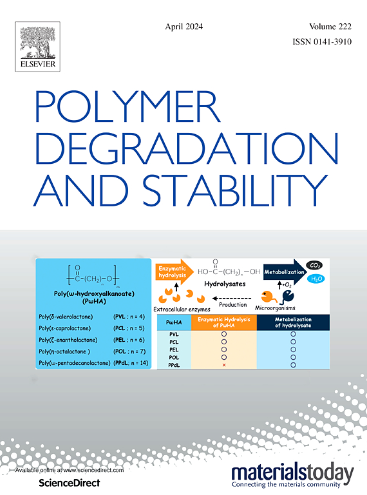可生物降解聚酯在海洋环境中的命运
IF 7.4
2区 化学
Q1 POLYMER SCIENCE
引用次数: 0
摘要
高分子材料的命运取决于聚合物的化学结构和环境条件。为了减轻与塑料使用寿命结束时管理不善相关的环境问题,人们对可堆肥和可生物降解聚合物给予了极大的关注。其中一些聚合物,即使是可生物降解的,也以微塑料的形式存在于环境中。在本研究中,利用模拟海洋环境中5种生物可降解聚合物(聚丁二酸丁二酯、PBS、聚丁二酸丁二酯-己二酸丁二酯)、PBSA、聚ε-己内酯、PCL、聚羟基丁酸酯、PHB、聚乳酸、PLA)在不同水深下363天的降解行为进行了研究。PCL和PHB在老化过程中有较高的质量损失。在测试结束时,在所有样品上都检测到裂纹、沟槽和孔洞。经傅里叶变换红外光谱和核磁共振光谱证实,暴露在海水中可引起聚酯的水解降解。砂中聚合物相的鉴定表明,在老化过程中,某些样品,特别是PCL,出现了碎裂现象。值得注意的是,并非所有的可生物降解聚酯都能在海洋中被生物降解,因此它们在使用寿命结束时的管理不善可能会导致环境中的逐步积累。本文章由计算机程序翻译,如有差异,请以英文原文为准。
The fate of biodegradable polyesters in the marine environment
The fate of polymeric materials depends on the chemical structure of the polymer and on environmental conditions. To mitigate environmental issues associated with plastic mismanagement at the end of life, great attention has been addressed to compostable and biodegradable polymers. Some of these polymers, even if biodegradable, are found in the form of microplastics in the environment. In this work, the degradation behavior of five biodegradable polymers, poly(butylene succinate), PBS, poly(butylene succinate-co-butylene adipate), PBSA, poly(ε-caprolactone), PCL, polyhydroxy butyrate, PHB, and poly (lactic acid), PLA, was evaluated using ad hoc set mesocosms simulating their presence in marine environment at different water depths for 363 days. Higher mass loss during aging was recorded for PCL and PHB. Cracks, grooves and holes were detected on all the samples at the end of the test. Exposure into seawater induces hydrolytic degradation of the polyesters confirmed by Fourier transform infrared and NMR spectroscopies. The identification of the polymer phase in the sand suggests the occurrence of fragmentation phenomena of some samples, particularly PCL, during ageing. Remarkably, not all biodegradable polyesters are biodegraded in the sea, thus their mismanagement at the end of life is likely to induce progressive accumulation in the environment.
求助全文
通过发布文献求助,成功后即可免费获取论文全文。
去求助
来源期刊

Polymer Degradation and Stability
化学-高分子科学
CiteScore
10.10
自引率
10.20%
发文量
325
审稿时长
23 days
期刊介绍:
Polymer Degradation and Stability deals with the degradation reactions and their control which are a major preoccupation of practitioners of the many and diverse aspects of modern polymer technology.
Deteriorative reactions occur during processing, when polymers are subjected to heat, oxygen and mechanical stress, and during the useful life of the materials when oxygen and sunlight are the most important degradative agencies. In more specialised applications, degradation may be induced by high energy radiation, ozone, atmospheric pollutants, mechanical stress, biological action, hydrolysis and many other influences. The mechanisms of these reactions and stabilisation processes must be understood if the technology and application of polymers are to continue to advance. The reporting of investigations of this kind is therefore a major function of this journal.
However there are also new developments in polymer technology in which degradation processes find positive applications. For example, photodegradable plastics are now available, the recycling of polymeric products will become increasingly important, degradation and combustion studies are involved in the definition of the fire hazards which are associated with polymeric materials and the microelectronics industry is vitally dependent upon polymer degradation in the manufacture of its circuitry. Polymer properties may also be improved by processes like curing and grafting, the chemistry of which can be closely related to that which causes physical deterioration in other circumstances.
 求助内容:
求助内容: 应助结果提醒方式:
应助结果提醒方式:


